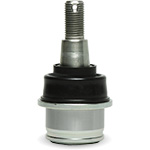As a ball joint manufacturer for more than 20 years, CCTY supplies leading brands with precision ball joints. Our worldwide network provides global access to these durable and proven ball joints.
When choosing a ball joint manufacturing partner, there are a few things to keep in mind to ensure that a quality partner is selected. They include:
- Manufacturer certification
- Raw material selection
- Production
- Heat treatment
- Testing
- Logistics
Certification for Ball Joint Manufacturers
When choosing a manufacturer, look for ISO 9001 and TS 16949. Both of these certification programs verify that the manufacturer has a series of processes that are strictly followed to provide consistent products. These quality management systems are designed to emphasize continual improvement, defect prevention and the reduction of waste.
TS 16949 is specific to the automotive industry
ISO 9001 branches across industries
Ball Joint Material Selection & Production
The ball joint manufacturing environment uses a range of skills, materials and procedures. Since ball joints perform a crucial function in harsh environments, it is important that they be manufactured to the highest standards.
A ball joint’s body and ball should be manufactured using high quality alloy steel. These parts then undergo through hardening to provide reliable performance.
The inner materials should be tailored to specific torque ratings. Each ball joint from CCTY is unique in design, made to fit a specific application. It is important to work with a manufacturer who understands how to eliminate tolerance stack up so that the end user is not inconvenienced with a ball joint malfunction.
A rubber seal or boot covers that stud and ball, and the amount of grease is maximized.
Ensuring a Long Service Life
A number of factors go into producing a ball joint that has a long service life. Below are the parameters that your manufacturer should follow:
- Corrosion resistance – Ball joints work in rough environments. In order to perform in elements that include salt, water and corrosive materials, ball joints need to be corrosion resistant. Oftentimes, the manufacturer will add a coating to help maintain a long-life ball joint. A strong seal will also prevent egress to dirt and salt, expanding the life of the ball joint.
- Ability to perform in high-temperature conditions – Heat can cause damage to any ball joint. Ball joints used in off-road or automotive applications must perform in high temperature conditions. Heat treatment to steel, fitting rubber boots and solid construction help ball joints withstand damage from heat.
- Reduction in tolerance stackup – Tolerance stack up can cause the ball joint to freeze or become too loose. Manufacturers who use injection molding eliminate tolerance stackup.
- Even Torque – Ball joints must operate with forces coming from a variety of direction. The ball joint must maintain torque to ensure accurate steering and smooth operation.
Ball Joint Manufacturing FAQs
Do ball joints need to be greased?
Some brands require periodic greasing. CCTY’s ball joints are greased for life, meaning that they are maintenance-free.
What’s the difference between an upper ball joint and lower ball joint?
Ball joints are part of the suspension that work within the chassis system. Generally, both ball joints do the same thing, however, one of the ball joints always has a lot more load than the other. The higher load ball joint is the one that is connected to the a-arm with the shock. The orientation and ball joint type can vary by the manufacturer design.
How do I know if a ball joint has gone bad?
A faulty ball joint will prevent the car from maintaining wheel alignment, which will become noticeable as uneven wear on the tires. When steering the car, the driver may notice vibration or that they have to turn the wheel a bit further to overcome excess looseness in the suspension. Sometimes a bad ball joint can be heard rattling.
What causes a ball joint to fail?
The environment ball joints work under includes salt, dirt and grime. Abrasive particles can get into the boot – or seal – if it does not fit properly or if it’s cracked. Driving under harsh conditions, such as bumpy or uneven roads, hard breaking and aggressive driving add to decay. This video will show you the inside of a ball joint.
Should the ball stud move freely?
The ball joint stud should freely pivot in the housing, yet be firm. It should not be able to plunge up and down within the housing.
What type of tests do ball joint manufacturers use to ensure a ball joint’s performance?
- Boot fatigue test.
- Fatigue tests for wear life.
- Axial and radial clearance.
- Ultimate load test of the ball stud.
- Ultimate push and pull out strength.
- Rotational torque and breakaway torque measurement.
- Material testing.
- Rivet area sealing test.

